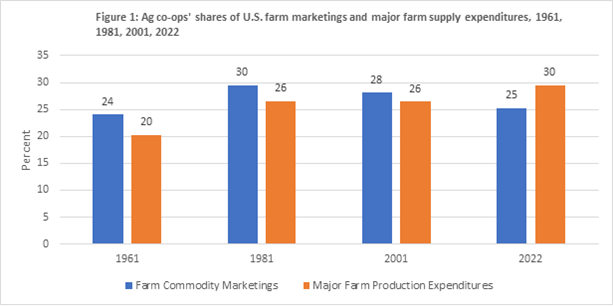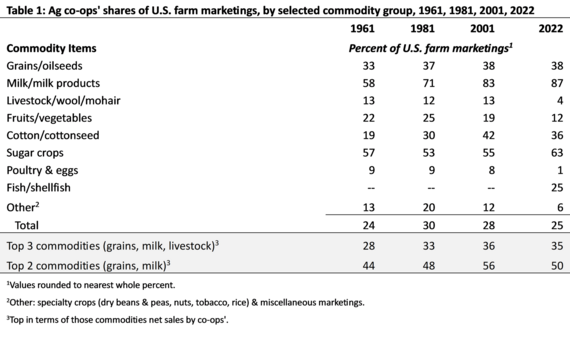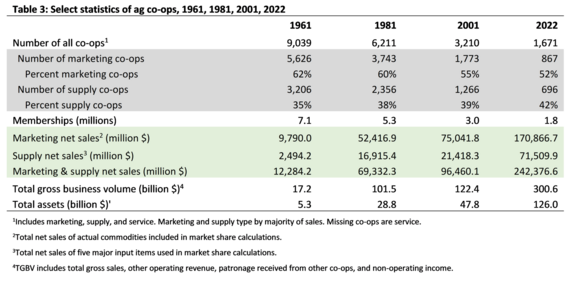|

May 8, 2024
Agricultural Cooperative Market Share
Commodities marketed and supply shares have fluctuated over time
Farmer cooperatives play an important role in agricultural markets. In 2022, 1,671 cooperatives serving 1.8 million producer-members reported several records: $301 billion in total gross business volume, $12.1 billion in net income, $126 billion in assets, and $54.8 billion in member-owned equity. Those substantial figures suggest that ag co-ops have established a prominent position in the marketplace. In past studies, USDA has estimated cooperatives’ market shares of commodities and major supply inputs, however, the last reporting was in 2001. Given the 20-year gap, market shares in the different commodity sectors and farm input areas were calculated with 2022 data for a more recent view of these performance measures and co-ops' relative market impact. Comparisons are made between 2022 market share values with those from the years 2001, 1981, and as far back as 1961.
Commodity Marketing Shares
Agricultural cooperatives’ share of total farm marketing—including crops, livestock, and poultry—was 25 percent in 2022, down from 28 percent in 2001 and from 30 percent in 1981, but for 1961, the share was lower at 20 percent (Figure 1). In 2022, cooperatives’ net commodity marketing business volume was $170.9 billion, and co-ops paid farmers $134.0 billion of that for their products.

|
|
|
By commodity items, cooperatives’ market share was highest for milk/milk products at 87 percent and then sugar at 63 percent (Table 1). Following were both grains/oilseeds and cotton/cottonseed at 38 percent. Other marketings included fruits/vegetables (12 percent share), livestock/wool/mohair (4 percent), poultry/eggs (1 percent), and other commodities combined were at 6 percent (breaking out the specialty crops of dry beans & peas, rice, nuts, and tobacco from that had that share at 17.3 percent). Compared to 2001, cooperative market share increased in milk/milk products and sugar, remained the same for grains/oilseeds, and decreased for livestock/wool/mohair, fruits/vegetables, poultry, and other marketings (and decreased as well for specialty crops broken out from other marketings). Co-op market share of fish/shellfish was 25 percent in 2022.
Grains/oilseeds, milk/milk products, and livestock make up the three highest net sales commodities of co-ops. When combined, the market share of these items dropped by 1 point from 2001 to 2022 to 35 percent. For the top two co-op sales commodities (grains/oilseeds and dairy/dairy products), the combined share dropped by 6 percent from 2001, to 50 percent for 2022.

|
|
|
Major Supply Input Shares
Agricultural cooperatives’ share of major farm production supply sales to the Nation's farmers—feed, seed, fertilizer, crop protectants, and petroleum—was 30 percent in 2022, up 4 points from 2001 (Figure 1). Cooperatives’ share of feed, seed, crop protectants, and petroleum all increased from 2001, while fertilizer share remained the same (Table 2).
Similar to 2001, co-ops’ market share of petroleum was highest among the five products in 2022, at 56 percent (an increase of 10 points since 2001). Market share of crop protectants and fertilizer were both at 45 percent, and crop protectants increased by 12 points from 2001. Feed share was 17 percent (up 2 points from 2001), and with seed at 15 percent, also up 2 points.

|
|
 Table 3 provides select data of ag co-ops for each of the four years highlighted in this bulletin. For co-op numbers, ag co-ops are designated as marketing or supply given their sales category majority for that given year. In 1961, there were 9,039 ag co-ops, of which 62 percent were defined as marketing co-ops. By 2022, there were 1,671 ag co-ops with 52 percent designated as marketing. Overall, there was an 81.5 percent drop in total co-op numbers in 61 years. However, during the same period, cooperatives’ marketing and supply net sales increased from $12.3 billion in 1961 to $242.4 billion in 2022. In real terms (2022 dollars), that was an increase of about 141.8 percent.
Implications of Ag Co-ops’ Market Share
This bulletin provides estimates of ag co-ops’ market share of commodities and major farm supply inputs, compared to similarly derived estimates from past points in time. In the commodity marketing sectors, what largely stands out is ag co-op market share in dairy with close to 90 percent of the milk and milk products marketed in the U.S. being handled by cooperatives, compared to 58 percent in 1961. That exhibits a dominant and increased market share among the 95 ag co-ops that marketed milk and milk products for producers in 2022. Sugar crop marketing by co-ops was another bright spot, with a rise in market share to more than 60 percent. Grains/oilseeds marketing stayed at the same relative share as in 2001, but the loss of co-op market share in livestock, as well as the share losses in fruits/vegetables, cotton/cottonseed, and poultry/eggs show a diminished level of co-op influence in those markets.
Overall, a 25 percent market share in total commodity marketing implies that ag co-ops and their members may actually have some opportunities to gain share in certain sectors. At the same time, co-op market share of the major two commodities of dairy and grain (as defined by sales volume) reflects a significant position by co-ops in these major sectors of the farm economy.
The 30 percent share of the major farm supply inputs can be viewed by co-ops as a positive, showing that they have been holding steady in their input sales to farmers over the years and have even made gains. Fertilizer share didn’t move since 2001, but the other categories all increased, driven by gains in crop protectants and petroleum. All the same, a good question remains: is 30 percent share a significant enough amount for co-ops? That level means that most sales to farmers (70 percent) of the major inputs still occur by firms other than cooperatives.
Cooperatives obviously are not the only player in agricultural markets, but they continue to play a critical role by providing services to the very farmers who own and control them as extensions of their farming operations. Opportunities for further engagement of farmers by co-ops should continue to be explored and as the number of co-ops decline, largely because of mergers between cooperatives, the resulting combined co-ops should use enhanced synergies for opening doors that may lead to further marketing and selling opportunities for producers.
Ag co-ops have proven to be innovative and sustainable, evidenced by the fact that 24 percent of co-ops today have existed for more than 100 years, and 74 percent are 50 years old or more. The 1,671 ag co-ops that reported for 2022 operated almost 9,500 locations across all 50 States exhibiting a strong presence in rural America’s farming communities. Such cooperative sustainability and locational reach should provide opportunities for capturing increased market share in certain agricultural industries.
**************
This bulletin is a snapshot of a longer bulletin containing this same information but expanded with additional data provided in nine figures and 11 tables over the periods covered. The longer edition also describes the methodology employed to estimate the market share measures and provides references. To request the more complete bulletin in .pdf form please email coopinfo@usda.gov
Bulletin Link: https://content.govdelivery.com/accounts/USDARD/bulletins/39a5dc8
|
|
|
|
|